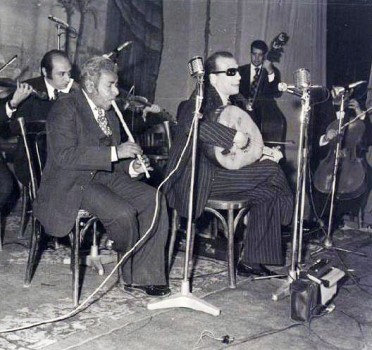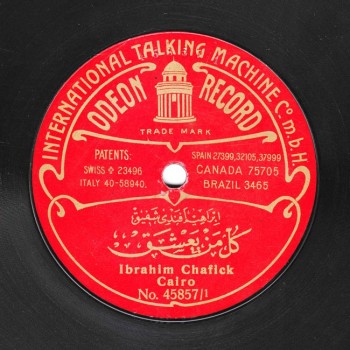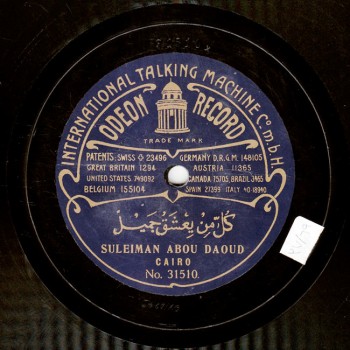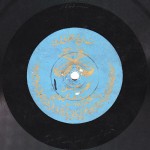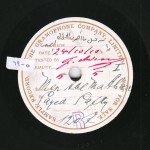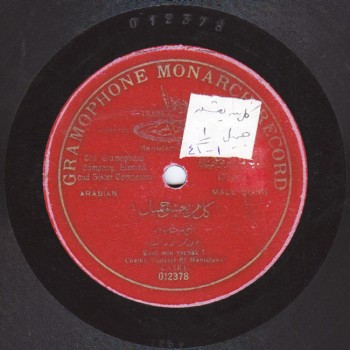 The Arab Music Archiving and Research foundation (AMAR), in collaboration with the Sharjah Art Foundation (SAF), presents “Sama‘ ”.
The Arab Music Archiving and Research foundation (AMAR), in collaboration with the Sharjah Art Foundation (SAF), presents “Sama‘ ”.
“Sama‘ ” discusses our musical heritage through comparison and analysis…
A concept by Mustafa Said.
Dear listeners,
Welcome to a new episode of “Sama‘ ”.
Today, we will resume our discussion about dawr al-mu‘āraḍa or dawr al-naẓīr.
In our previous episode, we concluded our analysis of dawr “Min abli mā ahwa el-gamāl”.
Today’s episode is dedicated to dawr “Kull mīn yi‘sha’ gamīl”, the dawr naẓīr to dawr “Min abli mā ahwa el-gamāl”.
They were both authored by the same poet, i.e. Sheikh Aḥmad ‘Āshūr, but not composed by the same person: “Min abli mā ahwa el-gamāl” was composed by Ibrāhīm al-Qabbānī, whereas todays’ dawr “Kull mīn yi‘sha’ gamīl” was composed by Ibrāhīm al-Qabbānī’s friend Dāwūd Ḥusnī. It is a dawr naẓīr and is thus composed to the same maqām, i.e. the bayyātī.
The oldest recording in our possession, to date, is Sheikh Ismā‘īl Ḥāfiẓ’ made in 1903 on two sides of a 78rpm disc (not a cylinder record). Unfortunately, we have not yet found a recording in the voice of Dāwūd Ḥusnī.
We have received many recordings, more than eight, including those of:
- Ismā‘īl Ḥāfiẓ made in 1903;
- Sulaymān Abū Dāwūd made by Odeon a little more than a year later, in late 1904/early 1905;
- Sheikh Sayyid al-Ṣaftī made by Favorite in 1905;
- Sheikh Yūsuf al-Manyalāwī made the same year by Bekka/Sama‘ al-Mulūk, the label dedicated to Sheikh Yūsuf al-Manyalāwī;
- Sheikh Yūsuf made by Gramophone in 1908, and whose matrix number is right before “Min abli mā ahwa el-gamāl”;
- Ibrāhīm Shafīq recorded on three Odeon record-sides a little more than two years later. It is an imitation of Sheikh Yūsuf’s. Later on, Ibrāhīm Shafīq worked as a muḥaffiẓ (memorization teacher) at the Egyptian Radio and, in many interviews, Sheikh Sayyid al-Mekkāwī stated that he memorized these dawr from Ibrāhīm Shafīq. So it seems that Ibrāhīm Shafīq taught Sheikh Sayyid Mekkāwī to memorize dawr “Kull mīn yi‘sha’ gamīl”;
- Sheikh Sayyid Mekkāwī who recorded it twice, once at the Egyptian Radio in the 1950s, and once again during the same period. Yet we do not know if the second recording was also made at the Radio, if it was a test recording made with others, or if it was the test recording of the first recording;
- Laure Dakkāsh who recorded the dawr during that same period in Beirut.
- Ibrāhīm Shafīq made by Baidaphon during the same period in 1911/12. This recording is similar to the Odeon record that is an imitation of Sheikh Yūsuf’s Gramophone record.
Let us listen to the madhhab of the oldest recording in our possession, i.e. the recording of Sheikh Ismā‘īl Ḥāfiẓ…
(♩)
Sheikh Ismā‘īl Ḥāfiẓ’ interpretation is calm, unlike dawr “Min abli mā ahwa el-gamāl” where the melody of the madhhab is repeated –as in traditional dawr. We said that Ibrāhīm al-Qabbānī composed another melody for the first tafrīd –we will discuss this later. But Dāwūd Ḥusnī repeated the same melody of the madhhab with the lyrics of the tafrīd that is not performed by the biṭāna…
(♩)
Beautiful Sheikh Ismā‘īl!
The lyrics are as follows:
Kam tikhāṭir we-inta ‘alīl Dah el-gharām yāmā kāwa”.
He performs waḥāyid without āhāt in “Dah el-gharām yāmā kāwa” …
(♩)
This is shared by almost all of them, including Ismā‘īl Ḥāfiẓ, Sayyid al-Ṣaftī, and Sulaymān Abū Dāwūd. They sometimes sang āhāt to perform the taslīm.
Let us listen a little…
(♩)
Ismā‘īl Ḥāfiẓ hinted at the waḥda “Lamā inta mush add el-hawa, bass ti‘sha’ lēh we-tmīl” but did not sing it.
(♩)
…Followed by “Bass ti‘sha’ lēh we-tmīl” to the jahārkāh that they all agree on.
Sheikh Yūsuf has another perspective in his two recording: he started with “Lamā inta mush add el-hawa, bass ti‘sha’ lēh we-tmīl”, performed a hank, āhāt, then went back to “el-gharām yāmā kāwa” from which he modulated back up to the jahārkāh. Let us listen to this…
(♩)
The second recording, made by Gramophone, includes the same feature.
Someone, maybe Ṣalībā al-Qaṭrīb, performed a waḥda to the Shūrī that does not exist in the dawr, while accompanying Sitt Laure Dakkāsh. Let us hear it…
(♩)
Then she performed the āhāt of Sheikh Yūsuf al-Manyalāwī in a very ordinary manner, yet differently… Still, she clearly took them from Sheikh Yūsuf…
(♩)
Let us listen how each of them modulates to the jahārkāh…
(♩)
Almost all of them modulate to the jahārkāh from the nawā or from the jahārkāh, i.e. either from the maqām’s third or from its fourth, except for Sulaymān Abū Dāwūd. Let us hear what he modulated from…
(♩)
He modulated from the fifth, i.e. the ḥusaynī… Incredible Sulaymān… What an excellent initiative!
All of them perform the ṣayḥa of the dawr with lyrics, except for Sayyid al-Ṣaftī whose ṣayḥa was always in the form of an āh, āhāt i.e. hank. He kept the hank for the ṣayḥa in the end. The ṣayḥa here is to the maqām’s initial position, i.e. the ‘ajam ‘ushayrān or the jahārkāh of the maqām’s initial position.
Let us hear it performed by Sheikh Sayyid al-Ṣaftī…
(♩)
This dawr, with all its elements, is dealt with by each of the artists at whim.
Let us listen to it in full performed by Sheikh Yūsuf al-Manyalāwī in a recording made by Gramophone that was published in 2011 within AMAR’s compilation of Sheikh Yūsuf al-Manyalāwī’s full works. Sheikh Yūsuf is accompanied by takht Muḥammad Afandī al-‘Aqqād (qānūn), Ibrāhīm Sahlūn (kamān), ‘Alī ‘Abduh Ṣāliḥ (nāy), Muḥammad Abū Kāmil al-raqqāq (percussions). The biṭāna includes ‘Alī Afandī ‘Abd al-Bārī and Sheikh Yūsuf al-Manyalāwī’s son Ḥasan Yūsuf al-Manyalāwī, among others…
(♩)
Beautiful Sheikh Yūsuf! Beautiful layālī in the beginning and beautiful taqsīm…
We will not listen to Ibrāhīm Shafīq’s recording imitating Sheikh Yūsuf’s.
We will listen to Sayyid al-Mekkāwī who allegedly memorized the dawr under Ibrāhīm Shafīq and recorded it around five decades after this recording.
Here are some remarks concerning this recording: Sayyid al-Mekkāwī had a talent in composing and, consequently, even while abiding perfectly by the structure of Sheikh Yūsuf al-Manyalāwī’s recording, he performed, in the middle, beautiful improvisations, waḥāyid, and āhāt as well as a beautiful dialogue with the ensemble.
The accompanying instrumentalists I can make out are, maybe: Ḥusayn Fāḍil (nāy), Fahmī ‘Awaḍ (qānūn), Labīb Ḥasan (violin), Ḥusayn Mu‘awwaḍ (percussions). Please note that these names are neither documented nor confirmed. Sayyid al-Mekkāwī is playing the ‘ūd, and he is accompanied by two other violinists –unknown to me. The accompanying biṭāna is the Egyptian Radio’s biṭāna..
Here is Sheikh Sayyid Mekkāwī performing dawr “Kull mīn yi‘sha’ gamīl”.
We will meet again in a new episode to resume our discussion about dawr al-naẓīr or dawr al-mu‘āraḍa.
In our next episode will discuss the comparison aspects, the similarities and the differences between these two dawr.
Let us now listen to Sheikh Sayyid al-Mekkāwī…
(♩)
“Sama‘ ” was presented to you by AMAR.
- 221 – Zakariyya Ahmed – 12 (1/9/2022)
- 220 – Zakariyya Ahmed – 11 (1/9/2022)
- 219 – Zakariyya Ahmed – 10 (11/25/2021)
- 218 – Zakariyya Ahmed – 9 (10/26/2021)
- 217 – Zakariyya Ahmed – 8 (9/24/2021)
- 216 – Zakariyya Ahmed – 7 (9/4/2021)
- 215 – Zakariyya Ahmed – 6 (8/28/2021)
- 214 – Zakariyya Ahmed – 5 (8/6/2021)
- 213 – Zakariyya Ahmed – 4 (6/26/2021)
- 212 – Zakariyya Ahmed – 3 (5/27/2021)
- 211 – Zakariyya Ahmed – 2 (5/1/2021)
- 210 – Zakariyya Ahmed – 1 (4/28/2021)
- 209 – W-al-Lāhi lā astaṭī‘u ṣaddak 2 (4/6/2017)
- 208 – W-al-Lāhi lā astaṭī‘u ṣaddak 1 (3/30/2017)
- 207 – Bashraf qarah baṭāq 7 (3/23/2017)

